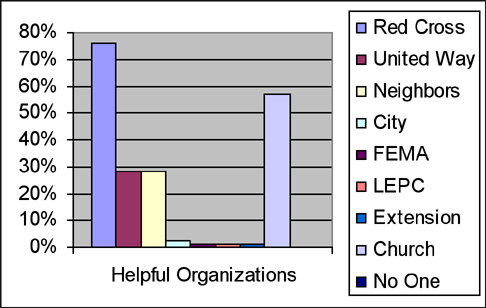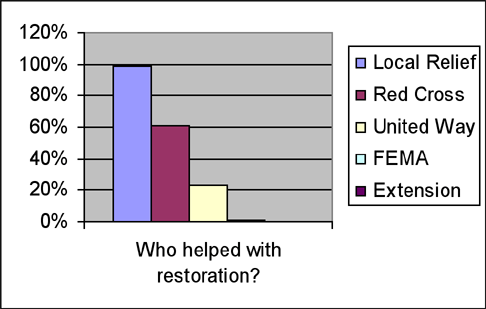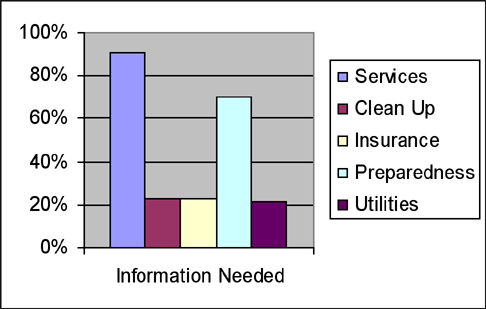December 2006 // Volume 44 // Number 6 // Commentary // 6COM1
Extension's Role in Homeland Security: A Case Study of Washington County, Utah
Abstract
As experience shows, Extension has a pivotal role to play in community disaster preparedness. The need for Extension offices to provide current, accurate emergency information and services is critical in helping mitigate loss to communities in the event of a natural or manmade disaster. Results from a survey conducted following a natural flood disaster in Washington County, Utah can provide knowledge that may be used in formulating effective services for your community.
Introduction
For more than 100 years, Extension has been an organization to help people solve problems. As we enter the 21st Century, Americans are facing critical issues that are requiring better emergency preparedness skills and self-reliance.
The need for Extension to become a stakeholder in American homeland security is evident. Extension's accurate knowledge and skills can assist communities in reducing loss in the event of a natural or manmade disaster. Knowing which hazards will be the most likely threat to your locality will help in determining what information you provide. FEMA lists the most common and widespread natural disaster in the United States as flooding. Your Local Emergency Preparedness Committee will be able to provide your Extension office with the hazards they feel pose the greatest risk to your particular location.
The disasters of Rita and Katrina are ample proof that communities and individual families should be prepared. In a time when government services are being reduced, local communities cannot and should not depend on the government to provide services to meet all needs should a crisis strike.
Washington County, Utah, has provided an example of how agencies do respond and how Extension will prepare to become a much needed information resource.
Background
January 10, 2005, St. George, Utah, a typical county with too little water for the needs of the residents, was experiencing the second week of significant rains. The previous 7 years had been so dry that the area residents were now rejoicing and grateful for the moisture.
As the snow continued in the mountains, the warm rains fell on the wildfire-damaged land of the previous two summers. These welcomed waters became part of a disaster that caught the county unprepared. The riverbeds of the Santa Clara and the Virgin were seldom filled with more than a trickle. True, these rivers had flooded over 100 years earlier, but no one believed that it could possibly happen again. As the rivers began to swell, they undercut the banks, swallowing up homes, farmlands, roadways, and a major source of the community revenues: golf courses. Over 50 families watched as their homes were destroyed or damaged by the raging rivers. One community became totally isolated from the county, with no power, water, or cell phone tower.
The county had an emergency preparedness plan in place, earthquakes being their number one concern for the community. No one had any idea that flooding of this magnitude could occur. Volunteers began sandbagging, and in some areas this saved many homes from water damage. Yet in other areas, the sandbags could not save homes or precious farmlands from being washed away.
Extension and Natural Disasters
How can Extension become more of a disaster prevention stakeholder? As the crisis unfolded, what was the role of Extension? We watched as the Federal Emergency Management Agency (FEMA) set up "camp" in our office building, emergency personnel were on call, and all county resources were stretched. We were unaware of what our role should be and how to best assist the county.
The National Research Council has indicated that communities can mitigate the loss to those they serve by compiling a database of information and cost-effective strategies that organizations, businesses, and communities can use to help in preparedness (National Research Council, 1999).
Method, Sample, and Results
In an attempt to better understand the role that Extension should have played, a post survey was administered. The survey was given to all community victims through local relief organizations. The surveys were voluntary and kept anonymous. The option to participate in this study was presented to all families involved in major flooding with loss of homes and property. Of these families, 48% of the flood victims completed and returned the survey, and 11% declined to participate. The results do not always equal 100%.
Figures 1-3 below depict the results of the tallied surveys, showing which organzaions provided services and information to vicitms.
The American Red Cross was perceived to be the organization of greatest help (Figure 1). In the early weeks following the flood disaster, they were not perceived by the community as an organization that had been helpful. Many individuals had donated money to the Red Cross Organization, thinking that the donations would immediately go to the flood victims. This did not happen quickly. Money donated to the Red Cross is used at the discretion of the organization.
Figure 1.
Helpful Organizations

The next organizations of help were the local churches. Church organizations seemed to have the ability to organize resources and provide food, housing, and emotional support.
FEMA (Federal Emergency Management Agency) came into the county, setting up their office in our building. They began assessing damage, checking bacteria levels, sewage issues, and additional safety factors. They initiated news coverage for television and radio, and provided support in applying and receiving federal dollars for our area.
The LEPC (Local Emergency Preparedness Committee) is responsible for all emergency operations within the county. This team was on call and actively involved; however, victims did not realize who they were. This team consisted of city and county police, search and rescue members, fire fighters, and other emergency support personnel who provided assistance in numerous ways.
USU Extension agents served as a resource to state and federal agencies, sharing information on agricultural concerns and on restoration of damaged lands and riverbeds. Information was gathered on rebuilding of pipelines and fences, and removal of sediment deposits. This information had to be on file and ready for immediate use. Sediment deposit areas, riverbed, and land restoration fact sheets had to be made available for the county residents.
As flooding subsided and the victims were left to clean up and rebuild, the perception that no one was offering information or support is evident (Figure 2). Over one half of the victims felt they were not given information on disaster cleanup, mold removal, sanitation issues, or disposal of flood ruins.
Figure 2.
Who Helped with Restoration?

Figure 3 shows the need for information about local services, cleanup, and better preparedness. Over 70% of the surveys indicated that respondents needed better knowledge and preparedness skills. Victims and community members living in flood zones were very concerned about insurance policies and premiums. One affected housing development had dropped its flood insurance a month prior to the disaster. Extension could take this knowledge and begin to build a database available to the community about the insurance and financial needs that county residents may wish to consider, a critical component for financial preparedness workshops.
Figure 3.
Information Needed

In the dissemination of information, Extension is a master. Our experience with research has provided valuable knowledge that is critical for disasters. We have access to EDEN, the Extension Disaster Education Network. This Web database has information on preparedness, services needed, and cleanup resources.
One Extension office in Breathitt County, Kentucky, was recently given recognition for StormReady Support. Their county Extension professionals are working to improve their ability to be prepared for and respond to emergencies. The message is that, that when we learn to help ourselves first, we will be more ready to help our clients--the people who depend on us for information. Breathitt County is the first in the state, but hopefully all Kentucky counties will want to follow suite (Kentucky County Extension's First StormReady Supporter, 2005).
Conclusions
From the survey material gathered and compiled, several conclusions can be drawn.
First, Extension was not a significant provider of services.
Second, all needs of the victims were not met.
Third, there are critical concerns that must to be prepared for, in event of future natural or manmade disasters.
These conclusions provide direction to Extension for offering future support and information to the community. More effective ways to share disaster information are needed. Information is the key element. The vulnerability of communities can be reduced with effective preparedness. Extension can become more assertive in disseminating information on preparedness and survival. One of the goals of Extension must be to share educational resources to reduce the impact of natural and manmade disasters, to provide support and assistance when the resources of individuals and families are overwhelmed and exhausted.
If your community were to experience a disaster, how prepared is your county Extension office to provide help, support, and information? Is your information accurate and current? Are news releases ready to provide critical information on water safety, and sanitation needs? Are fact sheets available on the restoration of lands in your area? If not, begin today.
Become a member of your local emergency preparedness team (LEPC) and/or your community emergency preparedness team (CERT). Most communities have LEPC that is continually assessing the emergency needs of a community. CERT programs are staffed by volunteers and sponsored by The American Citizen Corp Council. Both programs are valuable resources Extension offices should network with. Become a team member; help with 4-H youth CERT programs. When adequately trained, youth are a valuable resource in times of disaster; they are strong and full of energy
At a time of a natural or manmade disaster, citizens need to be prepared to self sustain for at least 72 hours. Extension can help mitigate the loss to their local communities by becoming an avenue of knowledge and information for the homeland security team.
References
Extension Disaster Education Network (EDEN). Available at: http://www.eden.lsu.edu
National Research Council (1999). The impacts of natural disasters: A framework for loss estimation. Washington, DC: National Academy Press.
US Department of Homeland Security--FEMA (2004). Are you ready? Maryland, IS-FEMA IS-22.
Pridday, T. (2005, November 18). Kentucky County Extension's first StormReady Supporter. Available at: http://www.eden.lsu.edu/news/Default.aspx
